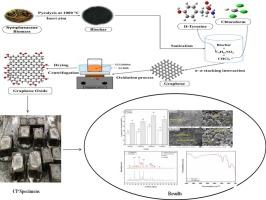绿色合成入侵植物氧化石墨烯增强水泥浆体微观结构和抗压强度
Q1 Environmental Science
引用次数: 0
摘要
在印度斯利那加的达尔湖等水生生态系统中,入侵物种,特别是睡莲(睡莲科)的大量繁殖,给水生生物带来了重大挑战。本研究通过利用入侵睡莲作为一种具有环保意识的方法,通过热裂解生产氧化石墨烯(GO),解决了这一问题。将合成的氧化石墨烯掺入水泥浆(CP)中(重量%范围为0 ~ 0.09),以探索其对可加工性、力学性能和微观结构的影响。氧化石墨烯浓度增加导致和易性降低。然而,氧化石墨烯对抗压强度有积极的影响,与对照CP相比,氧化石墨烯的抗压强度提高了0.06%,在第7天和第28天的抗压强度最大提高了53.7%和35.4%。XRD和FT-IR的微观结构分析表明,氧化石墨烯改善了水泥的水化、孔隙填充和致密的微观结构。特别是,氧化石墨烯在0.06%浓度下表现出显著的改善,表明其在提高机械性能方面具有重要作用。本文章由计算机程序翻译,如有差异,请以英文原文为准。

Green synthesis of graphene oxide from invasive plant species (Nymphaeaceae) for enhancing cement paste microstructure and compressive strength
The proliferation of invasive species, particularly water lilies (Nymphaeaceae), in aquatic ecosystems, such as Dal Lake in Srinagar, J&K, India, has led to significant challenges for aquatic life. This research addresses this issue by harnessing the invasive water lily as a resource for an environmentally conscious approach to produce graphene oxide (GO) through thermal pyrolysis. The synthesized GO was incorporated into cement paste (CP) (ranging from 0 to 0.09 wt%) to explore its impact on workability, mechanical properties, and microstructure. Increasing GO concentrations led to decreased workability. However, GO positively influenced compressive strength, with optimal enhancements observed at 0.06 %, a maximum enhancement in compressive strength of 53.7 % and 35.4 % at 7 and 28 days when compared to the control CP. Microstructure analysis through FE-SEM revealed improved cement hydration, pore filling, and densified microstructure, supported by XRD and FT-IR findings. Specifically, GO at 0.06 % concentration showed notable improvements, indicating its crucial role in enhancing mechanical properties.
求助全文
通过发布文献求助,成功后即可免费获取论文全文。
去求助
来源期刊

Bioresource Technology Reports
Environmental Science-Environmental Engineering
CiteScore
7.20
自引率
0.00%
发文量
390
审稿时长
28 days
 求助内容:
求助内容: 应助结果提醒方式:
应助结果提醒方式:


